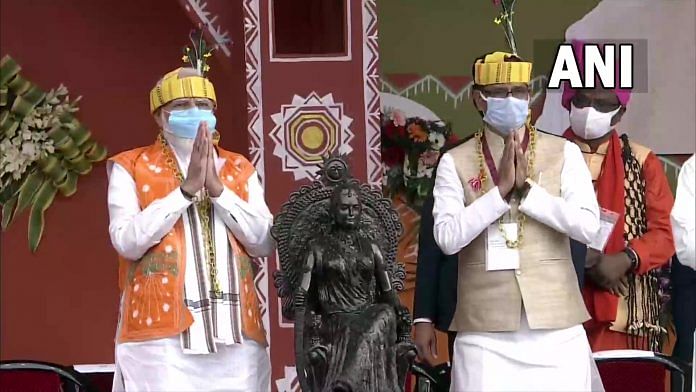New Delhi: Prime Minister Narendra Modi Monday inaugurated the newly-revamped Rani Kamlapati Railway Station, earlier known as Habibganj Railway Station, on a visit to Madhya Pradesh.
The Madhya Pradesh government had written to the Union Ministry of Home Affairs to rename the station, which has been upgraded and fitted with modern amenities.
The push to rename the station came from Chief Minister Shivraj Singh Chouhan who, in a blog post, hailed Rani Kamlapati as the pride of the Gond community and the last Hindu queen of Bhopal. According to Chouhan, her death led to Nawab rule in Bhopal.
Bhopal-based political analyst Girija Shankar said the renaming is part of the BJP’s trend of invoking regional heroes and leaders for political reasons, since the Gond community is the largest tribal group in India, with over 1.2 crore people, and according to the 2001 Census, in Madhya Pradesh, the Gonds are the second largest tribal group after the Bhils.
“The Gond tribe has a significant population in Madhya Pradesh. The BJP has been focusing on tribal communities for quite some time. This kind of symbolism is very important in politics to get a hold on people’s sentiments,” Shankar said. “The BJP has found a good tribal symbol in Rani Kamlapati, who herself has been on the margins in history. This seems like an effort to increase the BJP’s influence in the Gond tribe.”
Also read: Cow and its urine & dung can help strengthen India’s economy, says CM Chouhan
Who was Rani Kamlapati?
The 18th-century queen was one of the seven wives of Gond warlord Nizam Shah, who ruled his territory from Ginnor fort, the present day Ginnorgarh, in what is now Sehore district.
Nizam Shah had built a palace, the Kamlapati Mahal, for the queen in Bhopal, which was completed in 1722. The monument is designated as one of national importance and is protected by the Archaeological Survey of India (ASI).
Nizam Shah, according to Chouhan’s blog post, ruled over a territory that was formed with the merger of 750 villages in the 16th century by Suraj Singh Shah (Salaam), Nizam’s father.
According to the CM’s blog post, Nizam Shah was poisoned to death by his cousin Chain Singh, who wanted to marry Rani Kamlapati.
The queen went into hiding with her 12-year-old-son Nawal Shah and reached out to Afghan leader Dost Mohammad Khan, believed to be a mercenary in those days.
According to popular belief, Rani Kamlapati offered one lakh mohars (coins) to Dost Mohammad Khan and asked him to attack Chain Singh. Khan attacked the fort of Ginnorgarh, killed Chain Singh, and captured the fort.
But Khan, according to Chouhan, wanted to marry the queen as he was enchanted by her beauty, and also wanted to capture the entire princely state of Bhopal.
When the queen’s son Nawal Shah came to know of his intentions, the 14-year boy went on to fight Khan at Lalghati, but was killed.
The queen who didn’t buckle
James Tod, an officer of the East India Company and a scholar, has recounted the legend of the ‘Queen of Ganore’, Rani Kamlapati.
In his account, he compared the queen to Lucretia, the famous virgin from ancient Rome who saved her honour through suicide.
According to Tod, when Dost Mohammad Khan offered to marry the widowed queen, she presented him with a wedding attire and summoned him on the terrace of the palace.
“Know, Khan, that your last hour has come; our wedding and our death shall be sealed together. The vestments which cover you are poisoned; you left me with no other expedient to escape pollution,” Tod quotes the queen as having said, adding that she “sprung from the battlements into the river below”.
According to other popular legends, the queen took ‘jal samadhi’, having put all her jewellery and wealth into the pond.
According to the palace’s official history, the queen died in 1723.
(Edited by Arun Prashanth)
Also read: Why soft-spoken Shivraj Chouhan is now wielding ‘danda’, suspending officials at public rallies






